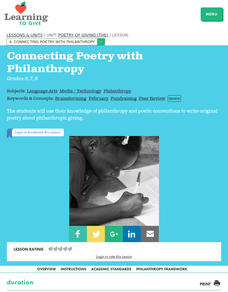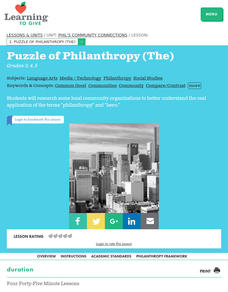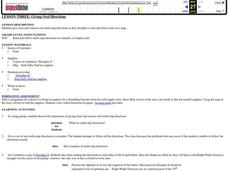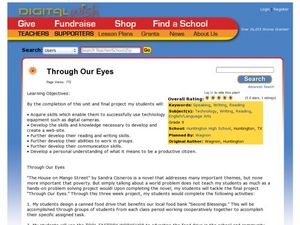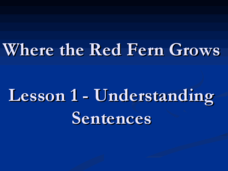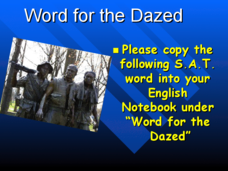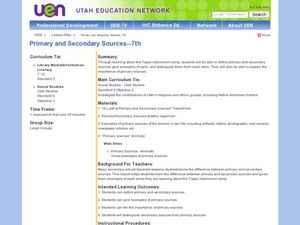Curated OER
Connecting Poetry with Philanthropy
Middle schoolers examine the different types of poetic conventions. They write a poem about philanthropy using these conventions. They illustrate their poem with artwork of their choice.
Curated OER
A Story of Giving
Students read a fable and identify their traits and values. They discuss how their family gives to others. They also predict the results of a lifetime of philanthropic giving.
Curated OER
Look at Philanthropy in Children's Literature
Students listen to stories about different philanthropic acts. They work together in groups to create a list of the needs of their community. They chose a service project which could be completed by their class.
Curated OER
The Puzzle of Philanthropy
Students research community organizations in their area. They identify three acts of philanthropy and three resources in the community that could help the common good. They reflect on their research in journal writings.
Curated OER
Giving Generously
Students are read a book about giving. They discover that giving to others is rewarding. They also locate China on a map and make their own rice cakes.
Curated OER
Giving Oral Directions
Students provide oral multi-step directions when helping someone follow a route on a map. In this directions lesson plan, students read examples of directions and then practice giving them on their own.
Curated OER
Poetry Alive! Interpreting Poetry Using Digital Images
Students investigate poetry by incorporating images into the words of a poem. In this language arts lesson, students discuss poetry writing devices and self expression with their classmates. Students create a film about the poem by...
Curated OER
Giving Students a Way to Publish Their Writing
Students are inspired to write about what they see using Internet publishing.
EngageNY
Writing a Position Speech: Which Food Chain Would Be Best?
Eeny, meany, miny, moe. It's time to choose a side. Scholars learn about taking a position by watching a video of a speech about local organic food. Next, pupils use graphic organizers to plan their speeches about which food chain is...
EngageNY
Creating a Visual Component for the Speech: End of Unit Assessment Preparation and Practice
Eye contact, volume, pronunciation. Working with partners, scholars practice presenting their speeches about the best food chain. Additionally, they choose a visual component to support their end-of-unit speech.
EngageNY
End of Unit Assessment: Presentation of Position
What is the difference between formal and informal language? Pupils rewrite their position speeches to adapt them for an audience of adults. Next, they present their speeches in small groups, attempting to answer the question, "Which...
Curated OER
After Reading: "Plot the Plot" Activity in the Library Media Class
"Plot the plot" of "The Adventures of the Speckled Band" with your young readers. Take a few days to read Sir Arthur Conan Doyle's short story as a class or in pairs, having learners write down what they consider to be the most important...
Curated OER
Speed Racers
A review of decoding words is incorporated in a discussion on reading with expression in order to increase fluency. The teacher gives several book options for readers to practice smooth and inflected reading, giving a short book talk on...
Curated OER
Teaching Peace through Literature and Song
Negative effects of bullying come to light through listening to the book Thank You, Mr. Falker by Patricia Polacco. Class members identify philanthropic acts portrayed in the story and make illustrations to connect them to their own...
Curated OER
Through Our Eyes
After reading Sandra Cisneros’ novel The House on Mango Street, class members design a canned food drive, create advertisements for the drive, and use digital cameras to document the entire process. In addition, pupils journal their...
Curated OER
Conventions - Punctuation Research
Study unusual punctuation marks in this punctuation lesson. Young grammarians work in small groups to research one of the unusual punctuation marks (semi-colon, colon, dash, comma, ellipses, or quotation marks) and discuss how the mark...
Curated OER
Deciding Theme
Read aloud to your class the fable "The Lion and the Mouse" as you explore characters' choices and the effects they have on a story. Apply what is discussed to finding a theme of the chapter "Not Giving Up" from The Wizard of Oz.
Curated OER
A Primary Source Picture Book
Travel through Europe with ten-year-old Teddy Roosevelt in this writing activity, which uses the picture book My Tour of Europe: by Teddy Roosevelt, by Ellen Jackson. After reading the book, readers compare it to passages from The...
Book Units Teacher
Where the Red Fern Grows: Understanding Sentences
Using sentences from the book Where the Red Fern Grows by Wilson Rawls, this presentation explores the use of correct grammar. It starts out by giving examples of complete and incomplete sentences, and then moves on to nouns, verbs, and...
Curated OER
Word for the Dazed: SAT Vocabulary
Prep those high schoolers for the S.A.T. by giving them one new word each day. There are 16 wonderful words, each with dictionary definitions and contextual example using a current pop-culture reference. Tip: Extend the daily vocabulary...
Curated OER
Primary and Secondary Sources - 7th
A link to a beautiful Animoto presentation is included, giving examples of primary sources that a student might want to contact when doing research. Using the Topaz Internment Camp in Utah as a sample topic, middle schoolers view a slide...
Curated OER
Hype!
Eight various activities have your learners looking at hype in the media. Advertisements for films, politics, music, and philanthropy all contribute to emotional appeals and marketing strategies trying to convince consumers to...
Curated OER
Emily Dickinson
The expanded timeline of Emily Dickinson's life is displayed on these slides. A plethora of information is presented covering main events, Dickinson's limited relationships, and her poetry. The majority of the slides contain the text of...
Curated OER
Correct the Homophones
Homophones are tricky! Build confidence in your young grammarians by giving them this practice sheet. There are 12 sentences shown that use one word incorrectly. Your learner must identify the homophone and rewrite the sentence using the...


